The advancement of modern surgical instruments has promoted the advancement of surgical technology. Against this background, in the field of gastrointestinal surgery, the emergence of staplers has brought digestive tract reconstruction to a new stage, shortened the operation time, reduced tissue damage and shortened the hospital stay. So in actual clinical work, what types of staplers are there? How to choose a stapler? Next, the author will take you into the world of staplers commonly used in gastrointestinal surgery.
Types of laparoscopic surgical stapler: There are many types of staplers, which are divided into two types according to the working principle: press-fit and staple-fit. According to the shape of the stapler, it is divided into linear cutting staplers, circular cutting staplers, arc-shaped cutting staplers, etc. Next, we will mainly classify the commonly used staplers in gastrointestinal surgery according to their shapes.
1. laparoscopic linear stapler
Product features: Although this stapler has only one function, it is widely used. It is mainly used for the closure of stumps such as bronchus, esophagus, stomach, duodenum, intestine, and blood vessels. Different models can be selected according to different tissues, but it should be noted that this type of stapler does not have a cutting function.

Note: Before loosening the stapler, remove the excess tissue and the organ to be removed along the edge of the stapler mouth, disinfect the broken end with iodine, and then loosen and remove the stapler.
2. Circular (annular) stapler
For this type of stapler, it can be divided into circular (anorectal) stapler and tubular (digestive tract) stapler according to the application.
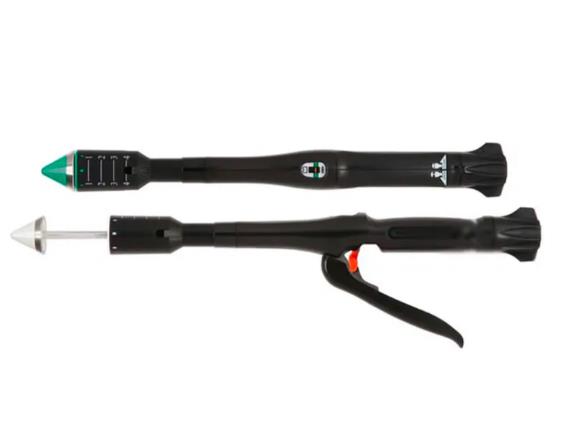
This type can be divided into: stapler PPH (hemorrhoidal circumcision anastomosis) and TST (open-loop minimally invasive hemorrhoidal stapler). The specific difference between the two is that TST is a selective stapler, which is a new technology developed on the basis of PPH procedure. TST uses a special anorectal scope to form different open-loop windows, uses anastomotic probes to lock hemorrhoids, and adjusts the resection range of hemorrhoidal mucosa according to the size and amount of hemorrhoids, protecting the normal function of the anus to the maximum extent.
3. Tube-type (digestive tract) stapler
Product features: Suitable for one-time surgery to avoid fork infection; enlarged curvature to facilitate the insertion of the instrument; integral circular knife to ensure reliability; unique needle design and processing, more conducive to suturing and resection.
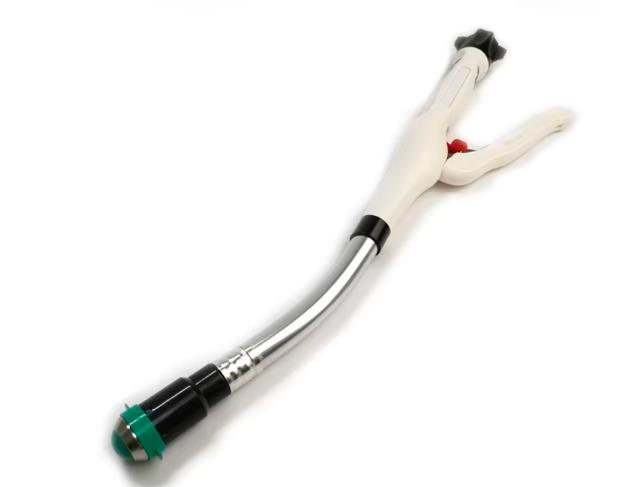
Notes: The intestinal end to be anastomosed should be fully freed and stripped at least 2 cm; the stapler should be withdrawn gently, and check whether the cut tissue is a complete ring; the purse string suture needle distance should not exceed 0.5 cm, the margin should be 2-3 mm, too much tissue is easy to be embedded in the anastomosis, hindering the anastomosis, be careful not to miss the mucosa.
4. Linear cutting stapler
Product features: large opening and closing mouth to help adjust the position; unique firing button to facilitate left and right operation; complete specifications, suitable for various surgeries; patented cam design, easier operation; the same instrument can replace the needle magazine suitable for tissues of different thicknesses.
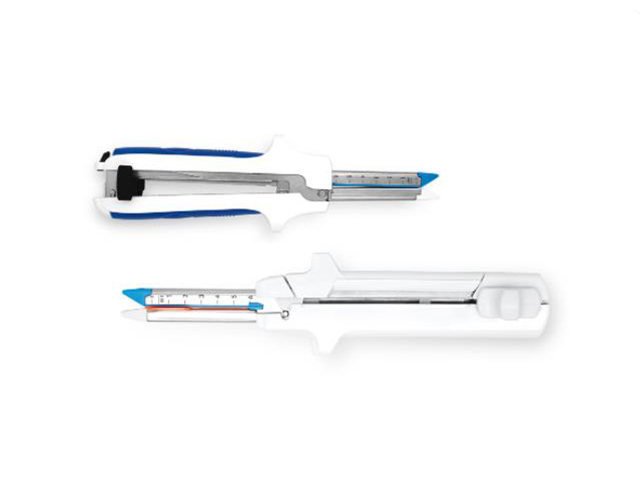
Notes: Do not open the instrument immediately after firing, and keep the instrument in a closed state for 15-20 seconds to enhance the hemostatic effect. The firing process is done in one go, and the firing should be pushed to the bottom. There should be no pause during firing. The tissue to be fired should be placed within the scale line (pay special attention to the tail end of the tissue) to avoid invalid operation. The correct use of the semi-locking device requires the tissue to be fired to be flat, without wrinkles and folds.
5. Arc-shaped cutting stapler
Product highlights: The instrument combines cutting and suturing, has the characteristics of small size and suitable for pelvic anatomy, and has certain advantages in low rectal cancer anal preservation surgery; cutting and suturing are completed simultaneously; unique arc-shaped head design; gasket that can be cut off; easy to insert into the pelvis; replaceable stapler; enter the lower position of the pelvis.
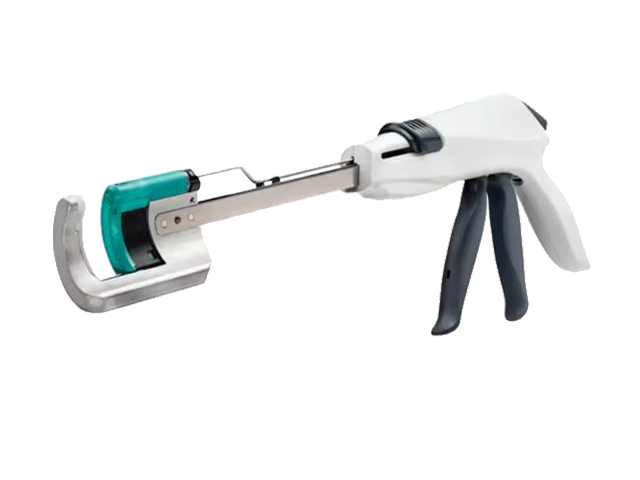
Precautions: Ensure that the anastomosis is free of tension. Under the premise of radical cure, moderately resect the proximal colon. When the anastomosis is suspected to have tension, the proximal colon should be fully freed or the splenic flexure of the colon should be loosened;
Selection of anastomotic site: The anastomosis should be made on the dorsal side of the midpoint of the rectal closed edge, and the intestinal wall of the lower rectum should contain part of the rectal closed edge. Because the free range of the dorsal side of the rectum is usually larger than that of the ventral side, and the blood supply is relatively poor, anastomosis here can reduce the blood-free area on the dorsal side.
After anastomosis, an anal digital examination is performed to check whether the staples are in a regular circle. Female patients are routinely examined for the posterior vaginal wall to ensure that there is no anastomotic damage.
6. Laparoscopic stapler
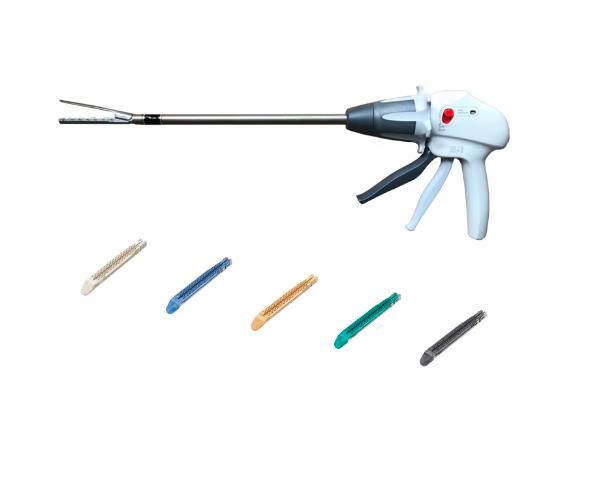
Product highlights: curved stapler magazine, more flexible operation in a narrow surgical space; equidistant gap control to ensure that the distal and proximal ends of the tissue are consistent; a disposable safety device is provided to avoid secondary firing of the used stapler magazine to ensure surgical safety; a wide front opening of the stapler magazine is convenient for tissue inclusion; the same instrument can be used with all types of stapler magazines to reduce the complexity of operation; this type of stapler has a total of 6 rows of staples, and there are new blades in the stapler magazine. While stapling, the blade cuts the tissue from the middle, so that 3 rows of staples on each side complete the functions of suturing and hemostasis; the stapler can rotate 360°, is designed with a manual release button, and adopts an ergonomic handle design, which can operate the entire firing process with one hand.
Note: Ensure that the anastomosis is free of tension; ensure blood supply to the anastomosis; be sure to select a nail gate with a corresponding nail leg length based on tissue thickness, and push the blade to cut and sever in the middle of several rows of staggered and evenly distributed titanium nail lines.